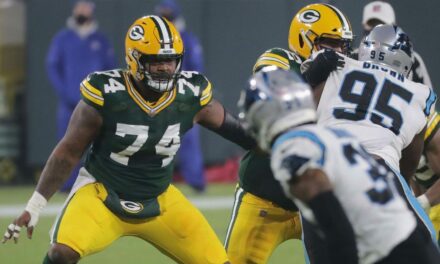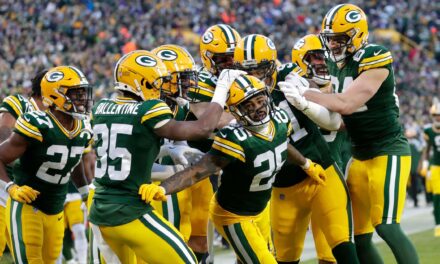The Green Bay Packers played poorly in Week 1 for the second straight year and lost to the Minnesota Vikings, 23-7. The loss drops the Packers to 0-1 on the season. The Packers lacked consistency on both sides of the ball and never really got into a rhythm. The offense couldn’t consistently move the ball and the defense had no answers for Justin Jefferson who had a dominant performance for Minnesota.
Here is a look at 10 things we learned from the Packers 23-7 loss to Minnesota:
- The Packers Missed Their Top Two Offensive Linemen
The Packers had neither David Bakhtiari nor Elgton Jenkins available for Week 1 and both players were inactive. The result was that the offensive line struggled to protect Aaron Rodgers and to open holes for the running game while the outcome was still in doubt.
Yosh Nijman started at left tackle while Royce Newman got the nod at right tackle. Jake Hanson filled in at right guard.
The most obvious result was that Rodgers was under constant pressure throughout the game. He was sacked four times and officially hit five more. More importantly, the Packers offense couldn’t get into any kind of consistent rhythm as a result.
During the game, the Packers lost starting left guard, Jon Runyan, Jr. to a concussion. He was replaced by Zach Tom who played well in his NFL debut.
- The Packers Defense Had No Answer for Justin Jefferson
The Packers couldn’t stop the Vikings star receiver all game long. He finished the game with nine catches on 11 targets for 184 yards and two touchdowns. The Vikings schemed him open often and were able to isolate him on inside linebacker Quay Walker and on the Packers two safeties which are clear mismatches.
The Packers opted not to match Jaire Alexander on Jefferson which would have been an option to try to limit Jefferson’s productivity. Instead, Eric Stokes struggled when he was asked to cover Jefferson as did anybody else who got that unenviable task in this game.
Joe Barry’s defense did not make enough adjustments once they were being beaten by Jefferson and the result was catch after catch for Jefferson and first down after first down for Minnesota.
- The Packers Had Their Chances to Change the Game
There were several chances for the Packers to change the momentum of the game but they came up short, time after time. After the Vikings scored on their opening drive, Rodgers came out and threw a long pass to rookie Christian Watson deep down the right sideline. Watson was open but he dropped what would have been a certain touchdown.
Early in the second quarter, the Packers still trailed just 7-0 and they put together their first solid drive of the season. The Packers went for it on 4th-and-goal from the one but A.J. Dillon was stopped short of the goal line and the Vikings took over on downs.
A 64-yard catch by Jefferson led to a field goal on Minnesota’s next drive and the Packers were down 10-0.
The Vikings scored their first touchdown on a fourth-down play while the Packers were stopped on their fourth down and goal at the one. These were key turning points in the game. When it mattered most, the Vikings executed and the Packers did not.
- Rookies Had a Mixed Day
The Packers rookies had their moments but also struggled at times. Watson had the big drop and wasn’t targeted again until the fourth quarter.
Walker was in on eight total tackles and looked quick at times but also struggled in coverage. He also left the game early due to injury.
Romeo Doubs finished with four catches for 37 yards although many of them came late in the game when the Vikings were giving the Packers the underneath stuff to keep the clock running.
Tom looked solid filling in while Devonte Wyatt made one assisted tackle and Kingsley Enagbare made two.
The rookies contributed and showed flashes but clearly have a way to go before the team can count on them week in and week out.
- The Packers Did Not Run the Ball Enough
The Packers were expected to emphasize the run more this season with Davante Adams no longer on the team and uncertainty at receiver. Not having Allen Lazard available for the season-opener only made the need to run the ball effectively more imperative.
But the Packers only ran the football 18 times all game and one of those was a kneel-down by Rodgers at the end of the first half.
Sure, falling behind early didn’t help, but this was still just a 10-point game until the final minute of the first half and the Packers failed to establish the running game.
Aaron Jones had just five carries all game while Dillon had 10. The Packers did average 6.2-yards per rush and gained 111 yards, but it wasn’t enough to get the offense in a groove and the Packers did not utilize two of their more reliable offensive weapons in Jones and Dillon enough.
- The Packers Defense Was Too Passive
Fans were expecting the Packers defense to take things to another level this season and they still may but in Week 1, the defense looked passive, especially early in the game.
Barry’s unit stayed back in a shell zone and the Vikings just schemed receivers open. The Vikings had 262 total yards by halftime and although the defense gave the Packers a chance to get back into the game in the third quarter, it was too little too late.
With the speed and talent on this defense, the team needs to utilize those weapons more effectively and not play the same old passive defense that caused the team to be victimized so often in recent seasons.
The run defense also failed to come up with some stops late in the game that could have kept the Packers fading hopes of a comeback alive.
- Aaron Rodgers Looked Frustrated
Everybody wondered how Rodgers would respond to the new receiving corps and how he would deal with the injuries along the offensive line. The answer was not particularly well.
When Watson dropped a perfect long pass on the Packers first offensive play, Rodgers was frustrated. He lacked time to throw and lacked targets he knew and trusted and just unable to overcome those obstacles to get production from the offense.
A closer look at the coach’s film will give us a better idea of whether Rodgers lacked open receivers or just didn’t trust the options he had but regardless of the reason, the offense needed more from Rodgers and all the players on the field than what they got in Week 1.
- Special Teams Weren’t Bad
Rich Bisaccia’s group made it’s regular season debut and the results were not bad. Punter Pat O’Donnell averaged 44.8-yards per kick and three of his four punts went inside the 20.
Amari Rodgers successfully executed four fair catches on punt returns and gained 12 yards on his only runback. He looked decisive when deciding whether to field punts and ran north-south to gain the 12 yards.
The coverage teams also did well, with one punt return by the Vikings gaining seven yards and one kick return 25. Not spectacular, but they didn’t hurt the Packers in any significant way either and that’s progress.
- The Game Had a Sense of Déjà Vu
This is the second straight season the Packers played poorly in Week 1 after resting their starters throughout the entire preseason. While this game wasn’t as embarrassing as last year’s debacle against the Saints, the Packers did not look sharp on either side of the ball and were not as ready to play as Minnesota was.
Head coach Matt LaFleur may want to rethink the way he prepares his team for the season opener because thus far, what’s he’s been doing hasn’t worked well.
- The Season Is Far From Over
It is far too early to panic. The Packers played worse a year ago in Week 1 and still won 13 games. The key is to see what kind of adjustments LaFleur, Barry and Rodgers make and how they come out against the Bears next week at Lambeau Field.
A win over Chicago gets the Packers right back into the thick of things. Let’s see how the team responds to this disappointing start to the season.
Follow Gil Martin on Twitter @GilPackers
Click here for more great Packers coverage



